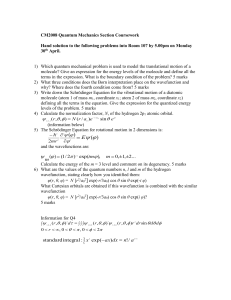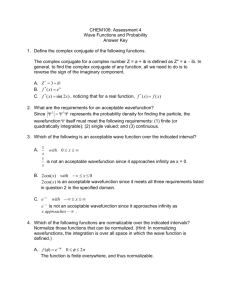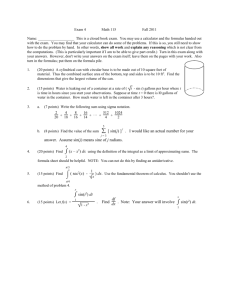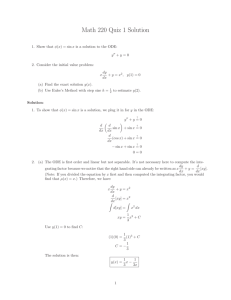Answers
advertisement
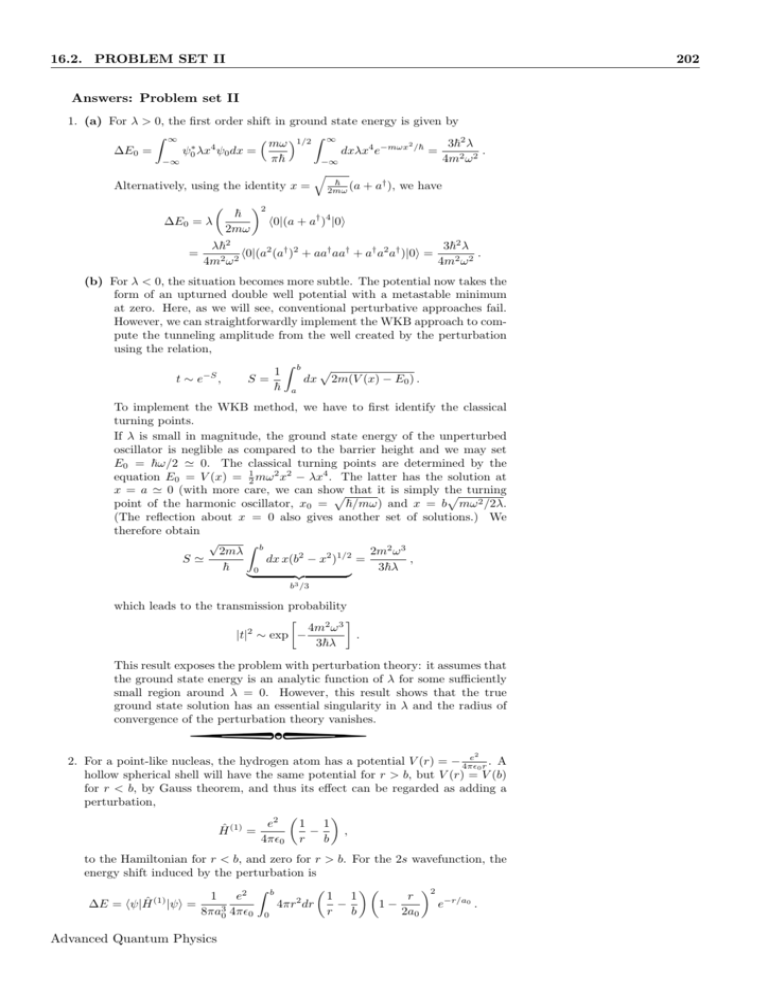
16.2. PROBLEM SET II 202 Answers: Problem set II 1. (a) For λ > 0, the first order shift in ground state energy is given by ! ∞ " mω #1/2 ! ∞ 2 3!2 λ ∆E0 = ψ0∗ λx4 ψ0 dx = dxλx4 e−mωx /! = . π! 4m2 ω 2 −∞ −∞ $ ! Alternatively, using the identity x = 2mω (a + a† ), we have &2 ! !0|(a + a† )4 |0" 2mω λ!2 3!2 λ 2 † 2 † † † 2 † = !0|(a (a ) + aa aa + a a a )|0" = . 4m2 ω 2 4m2 ω 2 ∆E0 = λ % (b) For λ < 0, the situation becomes more subtle. The potential now takes the form of an upturned double well potential with a metastable minimum at zero. Here, as we will see, conventional perturbative approaches fail. However, we can straightforwardly implement the WKB approach to compute the tunneling amplitude from the well created by the perturbation using the relation, ! 1 b ' −S dx 2m(V (x) − E0 ) . t∼e , S= ! a To implement the WKB method, we have to first identify the classical turning points. If λ is small in magnitude, the ground state energy of the unperturbed oscillator is neglible as compared to the barrier height and we may set E0 = !ω/2 % 0. The classical turning points are determined by the equation E0 = V (x) = 12 mω 2 x2 − λx4 . The latter has the solution at x = a % 0 (with more care, we can show ' that it is simply the ' turning point of the harmonic oscillator, x0 = !/mω) and x = b mω 2 /2λ. (The reflection about x = 0 also gives another set of solutions.) We therefore obtain √ ! 2mλ b 2m2 ω 3 S% dx x(b2 − x2 )1/2 = , ! 3!λ (0 )* + b3 /3 which leads to the transmission probability , 4m2 ω 3 2 |t| ∼ exp − . 3!λ This result exposes the problem with perturbation theory: it assumes that the ground state energy is an analytic function of λ for some sufficiently small region around λ = 0. However, this result shows that the true ground state solution has an essential singularity in λ and the radius of convergence of the perturbation theory vanishes. 2 e 2. For a point-like nucleas, the hydrogen atom has a potential V (r) = − 4π# . A 0r hollow spherical shell will have the same potential for r > b, but V (r) = V (b) for r < b, by Gauss theorem, and thus its effect can be regarded as adding a perturbation, % & e2 1 1 Ĥ (1) = − , 4π%0 r b to the Hamiltonian for r < b, and zero for r > b. energy shift induced by the perturbation is % ! b e2 1 1 2 (1) 4πr dr − ∆E = !ψ|Ĥ |ψ" = 8πa30 4π%0 0 r Advanced Quantum Physics For the 2s wavefunction, the 1 b &% &2 r 1− e−r/a0 . 2a0 16.2. PROBLEM SET II 203 Since b ' a0 , the terms involving r/a0 are negligible in the region of integration, so we can simplify the integral to % & ! b 1 1 e2 e2 b2 2 r dr R , R = ∆E = − = . ∞ ∞ 8π%0 a30 0 r b 6a20 8π%0 a0 Likewise for the 2p0 wavefunction, making the same approximation, we obtain &! π ! b % 1 1 e2 b4 4 2 r R∞ . ∆E = − dθ2π sin θ cos θ = 5 128π 2 %0 a0 0 r b 240a40 0 Both energy shifts are very small, but that for the 2p state is much smaller, because the 2p wavefunction vanishes at the origin. This is not a good method to explore the nucleus because other effects, such as spin-orbit interaction and other relativistic corrections would swamp the nuclear size effect. It is more effective for heavy atoms, with larger nuclei and smaller Bohr radii, and especially for “muonic” atoms, where the greater mass of the muon again reduces the Bohr radius. 3. If, without loss of generality, we take the field to lie along z, the perturbation is given by Ĥ $ = −eEz. At first order in perturbation theory, ∆E = −!0|eEz|0" vanishes since the ground state of the hydrogen atom |0" is an eigenstate parity. The leading contribution to ∆E is therefore the second order term ∆E = . |&k|eEz|0'|2 k%=0 E0 −Ek . If the induced dipole moment is d = α%0 E, its energy of interaction with the electric field is given by ∆E = − 12 d · E = − 12 α%0 E 2 . So, by comparing with our perturbation theory result we obtain the required result. An alternative derivation of this result starts from the first order perturbation . theory expression for the perturbed wavefunction: |ψ" = |0" + k%=0 ck |k", where ck = &k|−eEz|0' E0 −Ek . The dipole moment operator for the electron is ez, and its expectation value in this state is (neglecting small terms of order (c2k )), / !ψ|ez|ψ" = !0|ez|0" + [ck !0|ez|k" + c∗k !k|ez|0"] +O(c2k ) = α%0 E ( )* + k%=0 =0 ( )* + 2E P k!=0 |"k|ez|0#|2 Ek −E0 from which the value of α follows as before. Since Ek ≥ E1 for all k, we obtain α≤ 2e2 / |!k|z|0"|2 2e2 / !0|z|k"!k|z|0" 2e2 !0|z 2 |0" = = , %0 E1 − E0 %0 E 1 − E0 %0 E1 − E0 k%=0 k%=0 . where we have used the completeness relation I = k |k"!k|. Note that the sum now includes the k = 0 term. Using the explicit form for the Hydrogen ground state, |0" = ( πa1 3 )1/2 e−r/a0 , we evaluate the matrix element, 0 !0|z 2 |0" = !0|r2 cos2 θ|0" = ! π 2π sin θ cos2 θdθ 0 ! 0 ∞ r2 drr2 e−2r/a0 = a20 . We also need the energy difference, E1 − E0 = (1 − 14 )R∞ = which we obtain α ≤ experiment. 64πa30 3 = 9.9 × 10 −30 3 e2 4 8π#0 a0 from m , a figure that is not too far from 3 4. From trial wavefunction, we can obtained A from the normalization, 1 = 0 ∞ the 0a 2 5 |ψ|2 dx = A2 −a (x4 − 2a2 x2 + a4 )dx = 16 15 A a . Moreover, using the −∞ identity, % & , 2 !2 2 1 ! 1 2 2 2 2 2 4 Ĥψ = − ∂ + mω x ψ = A + mω (a x − x ) 2m x 2 m 2 Advanced Quantum Physics 16.2. PROBLEM SET II 204 the expectation value of the Hamiltonian is given by , 2 , ! a ! 1 15 2!2 4mω 2 a2 !ψ|Ĥ|ψ" = A2 (a2 − x2 ) + mω 2 (a2 x2 − x4 ) dx = + . m 2 8 3ma2 105 −a 1/2 ! Minimising with respect to a we obtain a2 = ( 35 2 ) mω . Substituting this value of a into our expression for$ !ψ|Ĥ|ψ", we obtain the upper bound on the 5 ground state energy, !ψ|Ĥ|ψ" = 14 !ω = 0.598!ω, which is greater than the true ground state energy (!ω/2) as expected. 5. From the normalization, 1 = A2 0∞ 0 4πr2 e−2βr dr = 4πA2 4β 3 β3 π . From 2β −βr , we r e ⇒ A2 = the identity ∇2 ψ = r12 ∂r (r2 ∂r ψ) = r12 ∂r (−βr2 e−βr ) = β 2 e−βr − have , % & ! ∞ !2 2β −2βr e2 −2βr !ψ|Ĥ|ψ" = A2 4πr2 dr − β 2 e−2βr − e − e 2m r 4π%0 r 0 !2 β 2 e2 β = − . 2m 4π%0 me2 4π#0 !2 = m e2 2 − 2! 2 ( 4π# ) 0 Minimising with respect to β we obtain β = a−1 0 , which is the inverse = −13.6 eV. This is the of the Bohr radius and thus !ψ|Ĥ|ψ" = correct value for the ground state energy of the Hydrogen atom, as expected, because we chose the correct functional form for the trial function. 6. (a) Suppose that the two Hamiltonians are Ĥ1 and Ĥ2 with ground state wavefunctions ψ1 and ψ2 , i.e. Ĥ1 ψ1 = E1 ψ1 , and Ĥ2 ψ2 = E2 ψ2 . Given that V1 ≤ V2 , we have Ĥ1 = Ĥ2 − V2 (r) + V1 (r) = Ĥ2 + ∆V (r). From the variational principle, E1 ≤ !ψ2 |Ĥ1 |ψ2 " = !ψ2 |Ĥ2 |ψ2 " − !ψ2 |∆V |ψ2 " = E2 + !ψ2 |∆V |ψ2 " ≤ E2 , where the last inequality follows because ∆V (r) ≤ 0. Thus E2 ≥ E1 . 2 ! (b) The Hamiltonian is given by Ĥ = − 2m ∂x2 + V (x), and the normalized trial 1/4 −λx2 function is given by ψ =$ (2λ/π) e . Using standard integrals, we 0 2 !2 2λ ∞ !2 obtain !ψ|Ĥ|ψ" = 2m λ + π −∞ dxV (x)e−2λx = 2m λ + I. Minimsing with respect to λ, we obtain, 1 ! 2 !2 I I 2λ 0= + + + V (x)(−2x2 )e−2λx , 2m 2λ 2λ π where the second term arises from differentiating the normalization in I, and the third term from differentiating the integrand. This is an implicit equation for λ and if we solve for I and substitute into the equation from above, we obtain 1 ! 2 !2 !2 2λ !ψ|Ĥ|ψ" = λ+I =− λ + 2λ dxV (x)(2x2 )e−2λx . 2m 2m π This is our upper bound on the ground state energy, and since V (x) ≤ 0, both terms are manifestly negative. Hence the ground state energy is negative, and at least one bound state must exist. 7. A single particle in the potential well has the (unnormalized) wavefunction and !2 π 2 2 energy, ψn (x) = sin(nπx/L) and E = 2mL ≡ %n2 . The wavefunction for a 2n system of two identical particles must be either symmetric or antisymmetric, i.e. ψ(x1 , x2 ) = sin(n1 πx1 /L) sin(n2 πx2 /L) ± sin(n2 πx1 /L) sin(n1 πx2 /L) , with energy (n21 + n22 )%. If E = 5%, we must have n1 = 1, and n2 = 2 (or vice versa). Advanced Quantum Physics 16.2. PROBLEM SET II 205 (a) Spin-zero particles are bosons and must have a symmetric wavefunction, ψ(x1 , x2 ) = sin(πx1 /L) sin(2πx2 /L) + sin(2πx1 /L) sin(πx2 /L) = 2 sin(πx1 /L) sin(πx2 /L) [cos(πx1 /L) + cos(πx2 /L)] . Clearly, this has zeros when x1 = 0, L, when x2 = 0, L, and when x1 + x2 = L. (b) Spin 1/2 particles are fermions and must have an antisymmetric wavefunction. In the singlet case, the spin wavefunction is antisymmetric, and hence the spatial wavefunction is symmetric, just as in (a). Symmetric wavefunction (c) In the triplet case, the spin wavefunction is symmetric, and hence the spatial wavefunction must be antisymmetric, i.e. ψ(x1 , x2 ) = sin(πx1 /L) sin(2πx2 /L) − sin(2πx1 /L) sin(πx2 /L) 2 sin(πx1 /L) sin(πx2 /L) [cos(πx1 /L) − cos(πx2 /L)] . Clearly, this has zeros when x1 = 0, L, when x2 = 0, L, and when x1 = x2 . If the particles were charged, they would repel each other through the Coulomb interaction. Therefore, in the spin 1/2 case, the triplet state would have the lower energy, because the particles tend to be further apart. This is an example of the exchange interaction, and is a simplified model of what happens in the Helium atom. Antisymmetric wavefunction 2 2 π ! 2 8. For the single-particle states, E = n2 8ma Since this well is not centred 2 = %n on zero, the single-particle eigenstates are all just proportional to sin(nπx/2a) ≡ |n". (a) If we write the two-particle states as |n1 , n2 ", the ground state is |1, 1" (E = 2%). The first excited states are |2, 1" and |1, 2" (E = 5%). The second excited state is |2, 2" (E = 8%). The overall wavefunction needs to be symmetric for bosons, which |1, 1" and |2, 2" are already. These therefore pair with a symmetric spin wavefunction, which is always possible, whether or not the bosons have spin zero. For the first excited state, both symmetric √ and antisymmetric combinations are possible: (|2, 1" ± |1, 2")/ 2; these would need to pair with spin wavefunctions that are respectively symmetric and antisymmetric. If S > 0, both are possible; if S = 0, only the symmetric space state is allowed. The (normalized) ground state wavefunction is given by ψ(x1 , x2 ) = !x1 , x2 |1, 1" = 1 sin(πx1 /2a) sin(πx2 /2a) . a (b) According to first order perturbation theory, the change in the ground state energy caused by Ĥ $ is given by ∆E = !Ĥ $ ", where expectation value 0 0 the ∗ $ involves the unperturbed eigenfunctions, ∆E = ψ (x 00 0 1 , x2 )Ĥ ψ(x1 , x2 )dx1 dx2 . Using the identity, f (x1 , x2 )δ(x1 − x2 )dx1 dx2 = f (x1 , x2 )dx1 , for any function f , we have ! ! ! 1 2V0 2a 4 2 ∆E = −2aV0 |ψ(x, x)| dx = − sin (πx/2a) = −4V0 sin4 (πy)dy . a 0 0 The sin4 (πy) looks nasty, but written as sin2 (πy)×sin2 (πy), with sin2 (πy) = (1 − cos(2πy))/2, it is easily evaluated and gives ∆E = −3V0 /2. Advanced Quantum Physics
